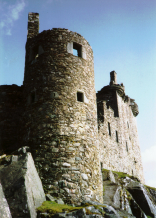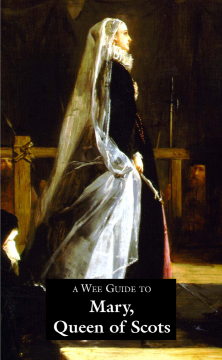Mary Queen of Scots: Return to Scotland
Ce qui m’était plaisant
Ores m’est peine dure
Le jour le plus luisant
M’est nuit noire et obscure;
Et n’est rien si exquis
Qui de moi soit requis
Throughout her life Mary turned to poetry to enable her to find expression for her emotions, and this Ode sur la mort, de son mari, Le Roi François II (Ode on the
death of her husband, King Francis II) fully expressed her grief and loss. This stanza describes metaphorically the loss of her husband as the loss of light in her life, which is now as dark as
night.
Mary wore the white of mourning that was expected of royalty, and embarked on forty days of isolation from public view. Apart from coming to terms with her own personal loss, Mary
was urged by her relatives to make plans for her future.
She was free to remain in France, where she now had no official position, or she could return to Scotland, where she could govern as monarch in her own
right. Rumours soon started about who and when she would remarry, rumours which were to follow her throughout her life. There were candidates aplenty – rich, poor, princes, kings, nobles – many were
considered in secret by Mary and her relatives, but all were dismissed except the heir to the throne of Spain, Don Carlos. François may have been fragile but Don Carlos was no great improvement.
Slight of build, suffering from epilepsy and a speech impediment, marriage to Don Carlos would appear to have been one of dynastic advantage, wealth and honour rather than attraction. The dynastic
possibilities – which would give Spain, one of France’s old rivals, a useful ally – were such that when Catherine de Medici discovered the plans, she persuaded Philip II of Spain, through her
daughter Elisabeth, that alliance with Scotland would be a dangerous and expensive venture. By spring 1561 the Spanish match was off.
The alternative of staying in France, without any official status, in a court controlled entirely by Catherine de Medici – who had now no reason to be amicable to her
daughter-in-law – was not a particularly attractive option. Mary began to consider the feasibility of returning to the land of her birth.
The danger, of which her advisors warned her, was that Scotland was now, to all intents and purposes, Protestant and Mary, as a Catholic monarch, would
have difficulties governing unless she managed to drive out the controlling Protestants. But Mary, who had received formal invitations to return from her half-brother Lord James Stewart and the
Scottish parliament, was less concerned about possible dangers, and increasingly aware that Scotland and the Scots were hers by birth. She was conscious that it was her responsibility to govern now
that the country lacked any official Regent. Another advantage was that she would not have to worry about her scheming mother-in-law.
Although the death of François had posed dynastic problems for Mary, in Scotland the concerns of those governing the country continued to be more about the Protestant settlement
and church organization. The Book of Discipline, the statement of reformed church policy, had taken some time to compile, and even by January 1561 its acceptance by nobles and lairds was only
qualified. The reformed church attempted to set up organization both at parish and higher level, but as a wider system of presbyteries would not appear until later, at this time supervision of the
parishes was to be done by superintendents. An embryonic form of assembly met in December 1560 and April 1562, but the Book of Discipline had not clarified the formal relationship between church and
state; was the state to have authority over the church or could the church develop an independent role from the state? These questions would remain at issue for many years.
It should be remembered that opinion in Scotland was divided, and that there were still areas of major disagreement. The possible return of Mary met with varied response – those
who might still be classed as Catholic welcomed the plan, others felt that Mary should only return if she agreed to marry the Protestant son of Châtelherault, James, third Earl of Arran. Yet another
alternative was that Mary should be allowed to return without having to compromise her religious beliefs, as long as she did not try to further a Catholic cause using foreign support.
An important aspect of the machinations behind negotiations was as ever the importance of relations between England and Scotland. Elizabeth was still unmarried, having recently
rejected the offer of the Earl of Arran, and therefore Mary still had a claim to the English crown. If Elizabeth could be assured that Mary did not intend to start a Catholic revival, then perhaps
Elizabeth would name Mary as her official heir. Lord James Stewart was sent to France with the Scottish offer and he advocated taking the third option, so Mary might return to Scotland, and remain
faithful to her chosen religion, as long as she did so in private.
Mary was in the north-east of France, with her Guise relatives, away from the pressures of the royal court, when Lord James arrived to open formal negotiations on behalf of the
Scottish parliament. Mary, possibly still in a state of grief and confusion, appeared to welcome the solid advice of her half-brother. She may have been loyal to the Catholic faith, but she was also
pragmatic and adaptable, especially when there were few alternatives available to her.
Although the official offer from Scotland had come through Lord James, Mary had received another possible route for her return from the Catholic Earl of
Huntly. Huntly had offered to raise troops in the north, to support her and force the rest of the country to convert, if she would sail directly to the north rather than Edinburgh. Mary demonstrated
a maturing political awareness by rejecting Huntly’s offer, and agreed to a policy of toleration and conciliation, both for Scottish Protestants and for herself. She wanted assurance that she would
be allowed to attend Mass and take Catholic communion in private with no interference. This was settled and Mary made preparations to leave France.
In the sixteenth century, travel in foreign lands required guarantees for safe conduct, and therefore as a formality, Mary applied to Elizabeth for safe passage through English
waters. Elizabeth was not satisfied that Mary had fully ratified the terms of the Treaty of Edinburgh, and so there was a delay after Elizabeth initially refused Mary’s request. Mary left Paris
on
25 July 1561, and set off for Calais accompanied by three uncles, friends, household servants and of course, the four Marys. By 14 August, although no official safe conduct had been received
from Elizabeth, Mary decided that she could no longer hold off her departure, and despite anxieties about possible interceptions by English ships, Mary and her entourage set off into a misty
horizon.
On 18 August, two ships were spotted off the coast flying blue flags bearing the French royal coat of arms. By the next day, the ships had reached the Firth of Forth and they
sailed into Leith harbour at about nine o’clock in the morning. A typical Edinburgh sight welcomed the returning Queen – a dense haar rising off the Firth of Forth obscured any view of the city.
Although the Scots knew her arrival was imminent, Mary had arrived sooner than expected and so as the royal party disembarked Mary was greeted by a relatively small crowd of local people and a few
officials.
The sight of their queen, dressed in mourning but accompanied by her colourfully dressed party, posed the local officials with a dilemma of protocol, as they had no idea where to
take her or what to do with her. No contingency plans had been made, so Lamb’s House, the house of a local merchant Andrew Lamb, was requisitioned for her use. There she could rest while messages
were sent to Edinburgh. The Scottish nobility began to descend on Lamb’s House by the afternoon and after some refreshment, escorted by her nobles, Mary travelled to Holyrood Palace. The way was lined with a cheering crowd welcoming her home,
pleased by the sight of their pretty young queen who herself appeared delighted by the warmth of the crowds. If Mary had doubts about her decision to return to Scotland when she first arrived, they
were dispersed by this joyous, enthusiastic support.
Mary was serenaded by the Edinburgh crowds during her first night at Holyrood, and Alexander Scott composed the poem ‘Ane New Yeir Gift’ to commemorate her arrival
Welcum, illustrat Ladye, and oure Quene;
Welcum oure lyone, with the ‘Fleur-de-lyce’;
Welcum oure thrissill, with the ‘Lorane’ grene;
Welcum oure rubent rois upoun the ryce;
Welcum oure jem and joyful genetryce;
Welcum oure beill of ‘Albion’ to beir;
Welcum oure plesand Princès, maist of pryce;
God gif ye grace aganis this guid new-yeir
(Alexander Scott, 1561)
The following Sunday, Mary attended Mass at the Chapel Royal at Holyrood Palace conducted by a French priest. When the Edinburgh citizens heard of this a less than friendly crowd gathered outside and attacked a royal servant.
The uproar drew the attention of Lord James, who true to his promise of allowing Mary religious freedom in the privacy of her household, persuaded the crowd to disperse. John Knox was to declare that this action indicated that Lord James had abandoned the Protestant cause, which was very much an exaggeration and typical of Knox’s emotive rhetoric. In Mary’s first proclamation as Queen of Scots she announced that she would not allow any change in the current state of religion in the country, thus permitting Protestant worship, but she maintained her right to participate in private Catholic worship.
Mary’s formal welcome to the Scottish capital included dinner at the castle, followed by a procession down the Royal Mile to Holyrood Palace. This spectacle was in similar vein to some of the festivities that Mary had seen in France. She was carried in a purple, gold fringed canopy preceded by 50 men disguised as moors, wearing black masks, black capes and yellow suits. There were maidens dressed as the Virtues, while others re-enacted mythological and religious legends. Cannon were fired from the castle, there was music and singing and welcoming speeches. The pageant also contained more subtle messages to Mary. A child, painted in gold, descended from a cloud and presented her with the symbolic keys to the city and two velvet covered books. One was the Bible, in English, and the other the Protestant service book. These clear symbols of the reformed faith spoilt the celebrations for Mary, and she summoned to Holyrood the man who she felt was the instigator of these ‘insults’. This was to be the first of several encounters with the man who for many is the image of Scottish protestantism and the Reformation – John Knox.
© Joyce Miller & Martin Coventry 2018









